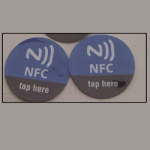Introduction:
NFC technology is pretty common these days and features in most high-end smartphones. As well as phone to phone communication, small little NFC tags can also be used to store and transfer information. You will probably have noticed small NFC tags next to advertisements near bus stops, stickers in shops, or may have even come across the clever idea of using NFC enabled business cards.
These tags can store wide range of information, from short lines of text, such as a web address or contact details, to links to apps in Google Play Store. It’s a quick and efficient way to quickly push information to your phone and these little tags can replace bar and QI code and could even be used instead of Bluetooth in some cases.
Features of AOPL NFC Tag:
- ISO/IEC 14443A.
- Operating Frequencies 13.56MHz.
- 1024 bit user memory.
- Chip: NXP NTAG203.
- Data Transfer Rate: 106Kbits/s.
RF Features
- Operating Frequency: 13.56MHz.
- Mode of Operation: Passive.
Electrical Characteristics
- Protocol: ISO/IEC 14443A.
- User Memory: 256 bit.
Inlay Material
- Antenna: Al, 30μm+/- 3μm.
- HF IC: Silicon, 150μm+/- 10μm.
- Substrate: PET, 38μm +/- 5μm.
ESD & Inlay Handling
- Human Body Mode: 1.5KV.
- Charged device Mode: 1.5KV.
Label Material of AOPL NFC Tag
- Surface Material: White writing paper, 80 g/㎡.
- Adhesive: Acrylic emulsion, 25μm+/- 3μm.
- Release Paper: White glassing paper, 60 g/㎡.
Environmental Specifications
- Shelf Life: 5 years.
- Recommended Storage Condition: -25℃ to +50℃, 20% to 90%RH.
- Operating Temp.: -40℃ to +65℃.
Label Specifications
- Label Size: Outside diameter 25mm.








